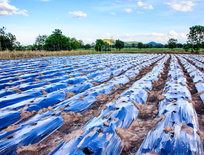|
Having trouble viewing this email? View it as a Web page.

|
|
|
Fresh from the
Field is a weekly album showcasing transformative impacts made by
partners supported by the National Institute of Food and Agriculture.
Editor: Falita Liles
July 26, 2018
|
|
Success Stories
 Managing
Onion Pests and Diseases May Lead to a $13 Million Increase in Crop Value
Onions are a widely grown and consumed
vegetable in the United States, but some growers are abandoning onion farming
because of losses due to pests and pathogens.
Researchers
at land-grant universities across the country have teamed up to help onion
farmers overcome these challenges. They have illuminated effective ways to
manage pests and diseases and identified onion varieties with greater resistance
or tolerance. These advances have transformed how onions are grown around the
world, making production more sustainable for farmers and ensuring a stable supply
for consumers.
Cornell
University researchers developed an integrated pest management (IPM) program
for thrips that combines selective insecticides, appropriate tank mixes and
additives, spray thresholds, resistance management, and reduced nitrogen
fertilizer use. Growers who used the program made 75 to 80 percent fewer insecticide
applications per field and saved an average of $265 to $300 per acre. In the Columbia
Basin of Washington and Oregon, adopting IPM practices to control thrips could increase
onion crop value by more than $13 million per year.
NIFA
supports this research through the Multistate Research Fund.
Read the full story
at the Multistate Research Fund Impacts Page. USDA photo.
|
News Coverage

Biogradable Plastic Mulch
Biodegradable mulches have
been promoted as an environmentally-friendly alternative to plastic mulches.
However, according to Washington State University graduate student Henry
Sintim, more research is needed to determine how much these mulches actually do
degrade and what impacts they might have to the soil.
It is assumed that
microorganisms in the soil break down the biodegradable plastic mulch mainly to
water, carbon dioxide, and biomass. But to what extent?
Sintim’s Western
SARE-funded graduate student project tests four biodegradable plastic mulches.
The good news is that in the early stages of the project the biodegradable
plastic mulches maintain soil microclimate similar to the polyethylene mulch
and provide similar benefits. While the project is still on-going, composting
the mulches resulted in more degradation than tilled in soil so this could be a
viable disposal method.
NIFA
supports this research through the Western SARE grant program and the Specialty
Crop Research Initiative.
Learn more about biodegradable mulch
at the University of Tennessee. Photo credit: Getty Images.
|
Library
 Cross-Laminated Timber Development
Cross-laminated timber (CLT) are massive building
panels can be manufactured with lumber from thin trees that are susceptible to
pest outbreaks and pose catastrophic fire threats. CLT can allow faster
construction and is beginning to revive local economies in the Northwest.
Since
2011, researchers at Washington State University’s (WSU) Composite Materials
and Engineering Center have worked with local companies, governments, and
economic development groups to improve the performance and manufacturing
process of cross-laminated timber as well as analyzing cost effectiveness and
logistics of a rural to urban supply chain.
WSU is already working with milling
and manufacturing partners to launch a supply chain in Eastern Washington and
to identify other Western Washington opportunities.
NIFA supports this research through McIntire-Stennis
Capacity Grants.
Learn more at CleanTech Alliance. Photo courtesy of Structurlam.
|
Tweet of the Week
#NIFAIMPACTS

|
|

NIFA’s mission is to invest in and advance agricultural research, education, and extension that solve societal challenges. NIFA’s investments in transformative science directly support the long-term prosperity and global preeminence of U.S. agriculture. To learn more about NIFA’s impact on agricultural sciences, visit www.nifa.usda.gov/Impacts, sign up for email updates or follow us on Twitter @USDA_NIFA, #NIFAImpacts.
USDA is an equal opportunity lender, provider, and employer.
|
|